Situation Analysis of Fonterra: SWOT, PESTLE, Competitor Analysis
VerifiedAdded on 2023/06/14
|14
|3014
|474
AI Summary
This situation analysis of Fonterra includes SWOT analysis, PESTLE analysis, competitor analysis, and analysis of internal and external environment. It also covers the history, strategic business unit, industry classification, and key customers of Fonterra.
Contribute Materials
Your contribution can guide someone’s learning journey. Share your
documents today.
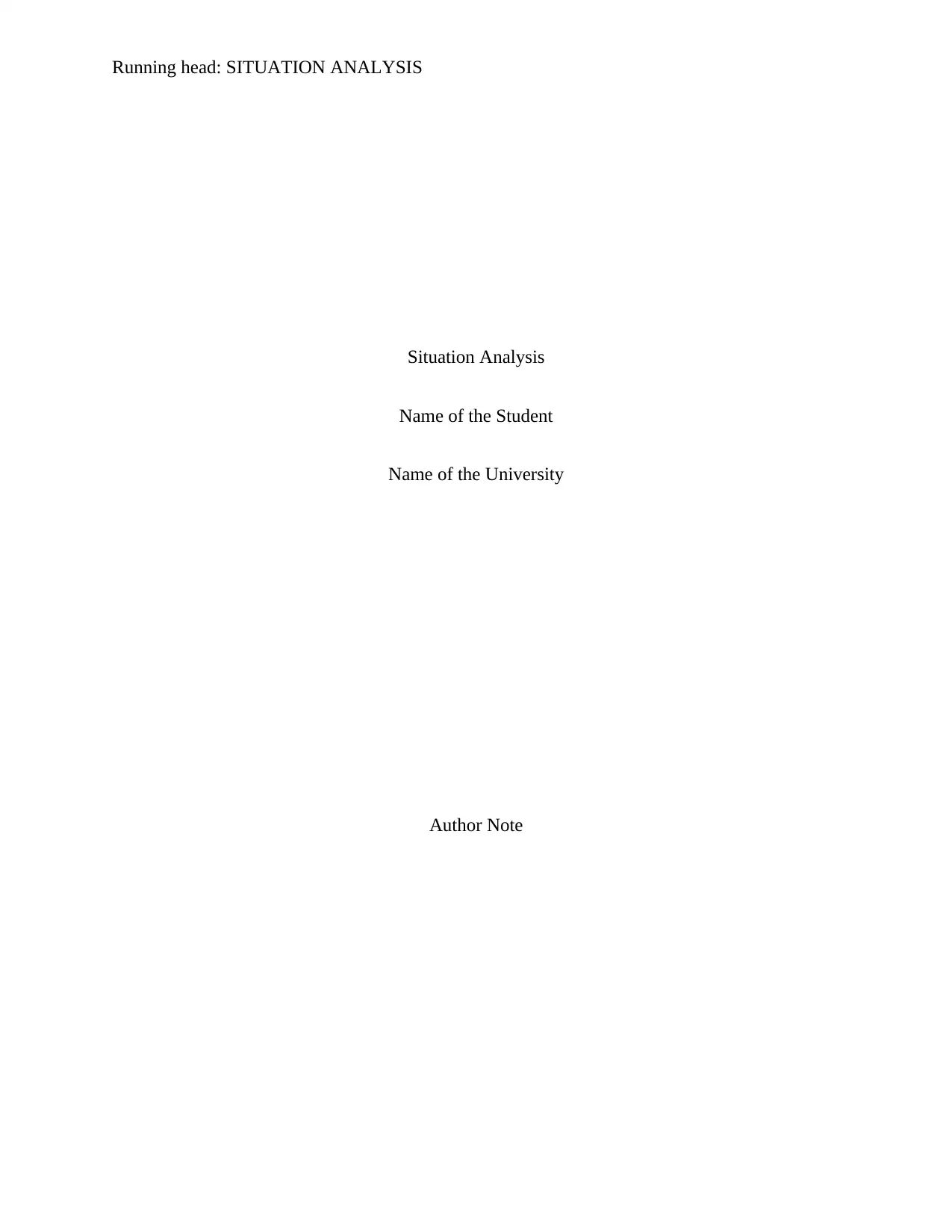
Running head: SITUATION ANALYSIS
Situation Analysis
Name of the Student
Name of the University
Author Note
Situation Analysis
Name of the Student
Name of the University
Author Note
Secure Best Marks with AI Grader
Need help grading? Try our AI Grader for instant feedback on your assignments.
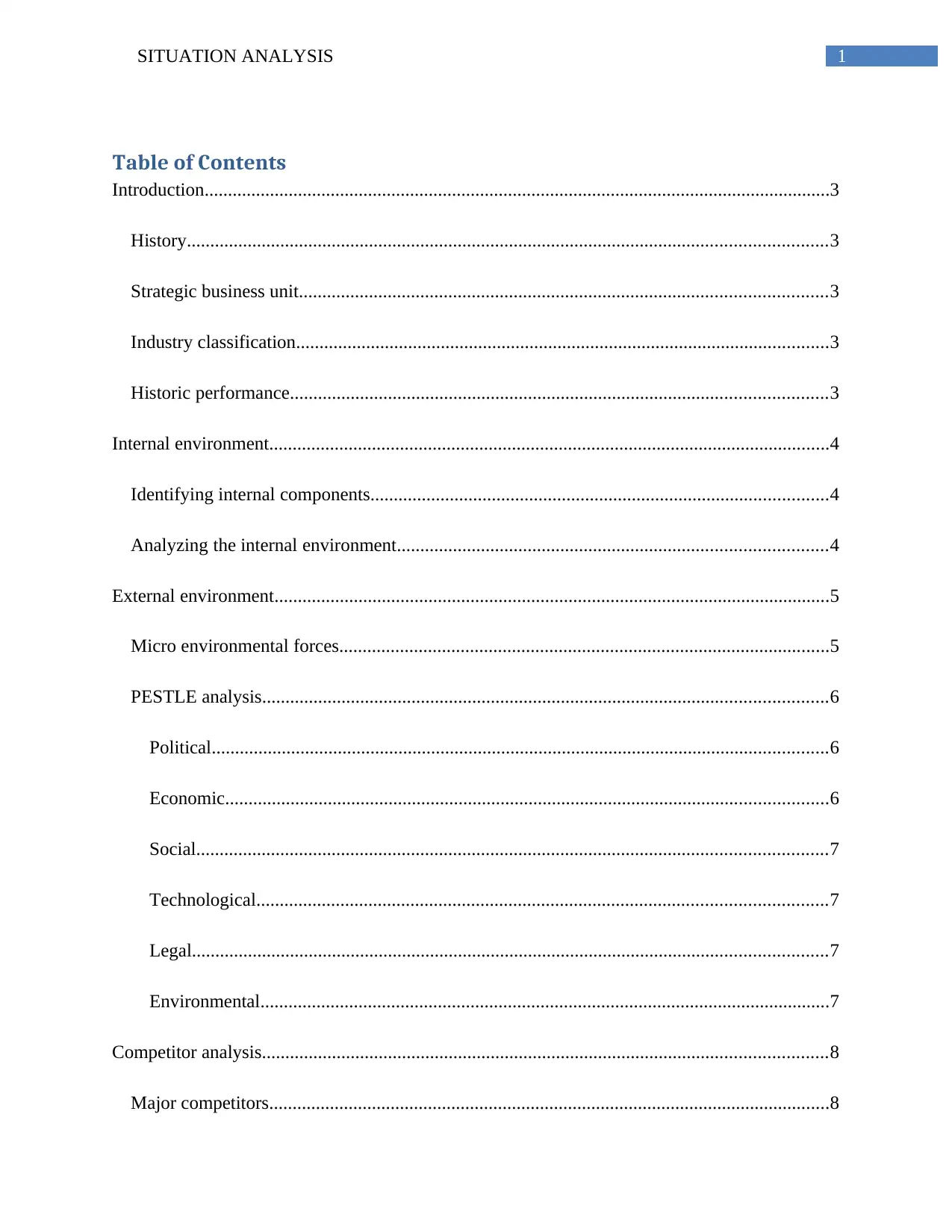
1SITUATION ANALYSIS
Table of Contents
Introduction......................................................................................................................................3
History.........................................................................................................................................3
Strategic business unit.................................................................................................................3
Industry classification..................................................................................................................3
Historic performance...................................................................................................................3
Internal environment........................................................................................................................4
Identifying internal components..................................................................................................4
Analyzing the internal environment............................................................................................4
External environment.......................................................................................................................5
Micro environmental forces.........................................................................................................5
PESTLE analysis.........................................................................................................................6
Political....................................................................................................................................6
Economic.................................................................................................................................6
Social.......................................................................................................................................7
Technological..........................................................................................................................7
Legal........................................................................................................................................7
Environmental..........................................................................................................................7
Competitor analysis.........................................................................................................................8
Major competitors........................................................................................................................8
Table of Contents
Introduction......................................................................................................................................3
History.........................................................................................................................................3
Strategic business unit.................................................................................................................3
Industry classification..................................................................................................................3
Historic performance...................................................................................................................3
Internal environment........................................................................................................................4
Identifying internal components..................................................................................................4
Analyzing the internal environment............................................................................................4
External environment.......................................................................................................................5
Micro environmental forces.........................................................................................................5
PESTLE analysis.........................................................................................................................6
Political....................................................................................................................................6
Economic.................................................................................................................................6
Social.......................................................................................................................................7
Technological..........................................................................................................................7
Legal........................................................................................................................................7
Environmental..........................................................................................................................7
Competitor analysis.........................................................................................................................8
Major competitors........................................................................................................................8
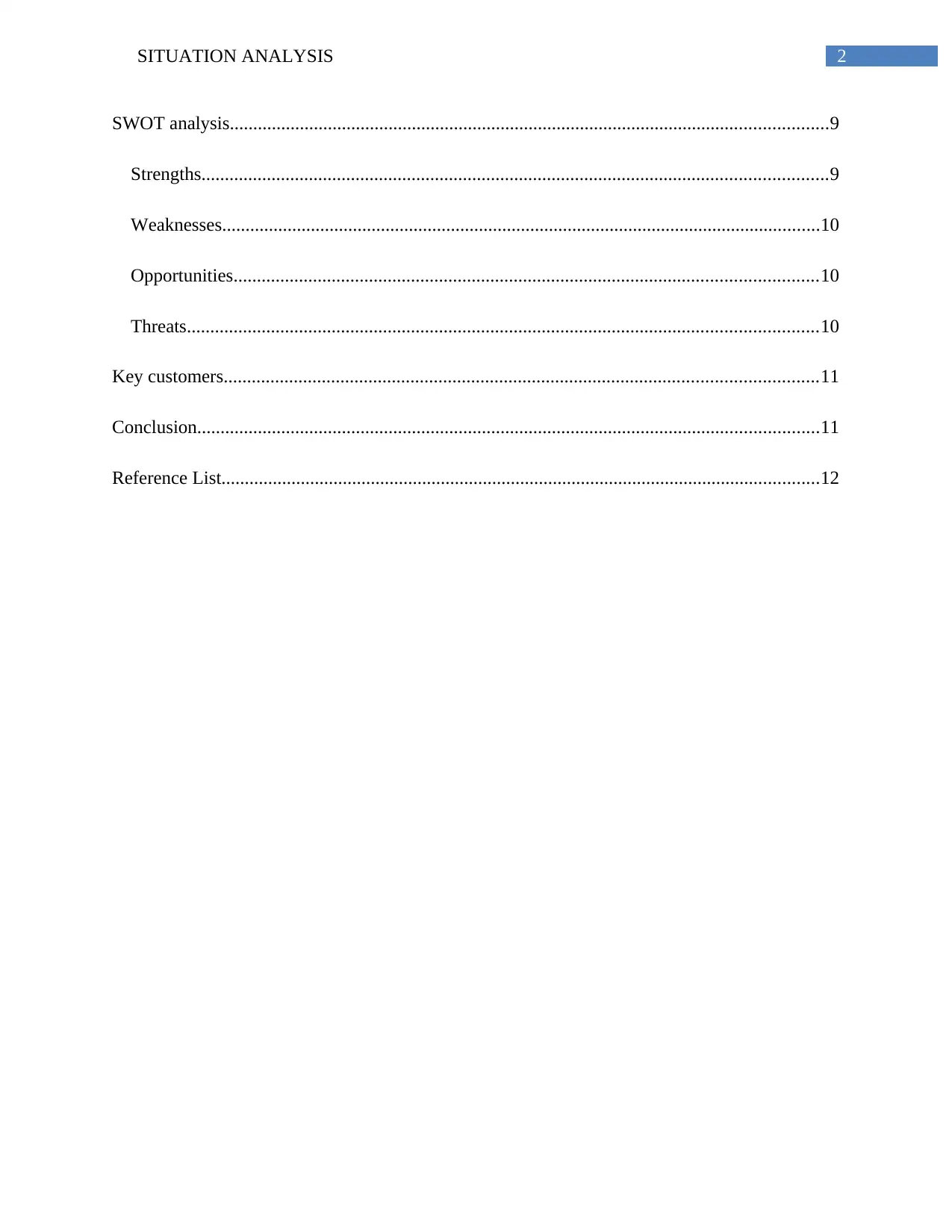
2SITUATION ANALYSIS
SWOT analysis................................................................................................................................9
Strengths......................................................................................................................................9
Weaknesses................................................................................................................................10
Opportunities.............................................................................................................................10
Threats.......................................................................................................................................10
Key customers...............................................................................................................................11
Conclusion.....................................................................................................................................11
Reference List................................................................................................................................12
SWOT analysis................................................................................................................................9
Strengths......................................................................................................................................9
Weaknesses................................................................................................................................10
Opportunities.............................................................................................................................10
Threats.......................................................................................................................................10
Key customers...............................................................................................................................11
Conclusion.....................................................................................................................................11
Reference List................................................................................................................................12
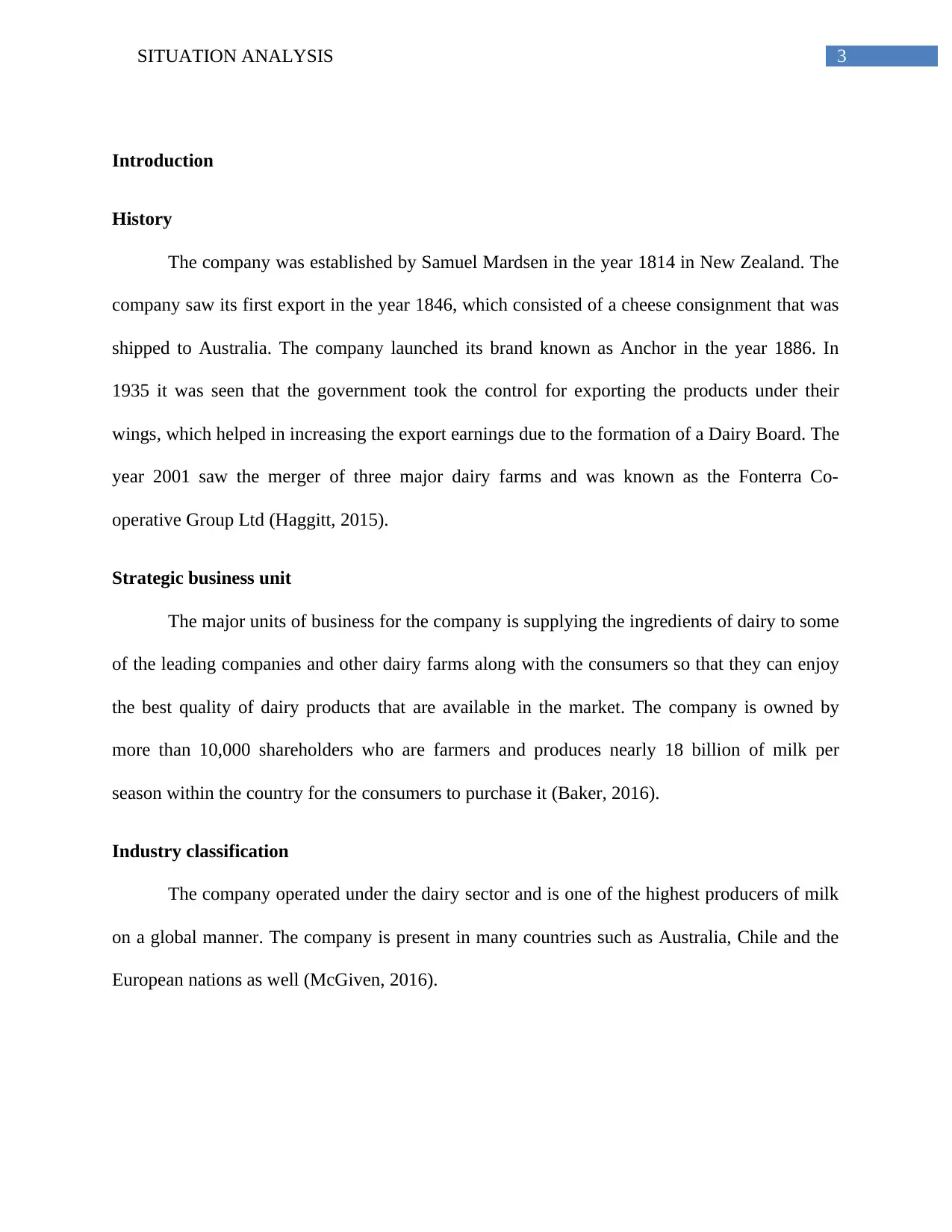
3SITUATION ANALYSIS
Introduction
History
The company was established by Samuel Mardsen in the year 1814 in New Zealand. The
company saw its first export in the year 1846, which consisted of a cheese consignment that was
shipped to Australia. The company launched its brand known as Anchor in the year 1886. In
1935 it was seen that the government took the control for exporting the products under their
wings, which helped in increasing the export earnings due to the formation of a Dairy Board. The
year 2001 saw the merger of three major dairy farms and was known as the Fonterra Co-
operative Group Ltd (Haggitt, 2015).
Strategic business unit
The major units of business for the company is supplying the ingredients of dairy to some
of the leading companies and other dairy farms along with the consumers so that they can enjoy
the best quality of dairy products that are available in the market. The company is owned by
more than 10,000 shareholders who are farmers and produces nearly 18 billion of milk per
season within the country for the consumers to purchase it (Baker, 2016).
Industry classification
The company operated under the dairy sector and is one of the highest producers of milk
on a global manner. The company is present in many countries such as Australia, Chile and the
European nations as well (McGiven, 2016).
Introduction
History
The company was established by Samuel Mardsen in the year 1814 in New Zealand. The
company saw its first export in the year 1846, which consisted of a cheese consignment that was
shipped to Australia. The company launched its brand known as Anchor in the year 1886. In
1935 it was seen that the government took the control for exporting the products under their
wings, which helped in increasing the export earnings due to the formation of a Dairy Board. The
year 2001 saw the merger of three major dairy farms and was known as the Fonterra Co-
operative Group Ltd (Haggitt, 2015).
Strategic business unit
The major units of business for the company is supplying the ingredients of dairy to some
of the leading companies and other dairy farms along with the consumers so that they can enjoy
the best quality of dairy products that are available in the market. The company is owned by
more than 10,000 shareholders who are farmers and produces nearly 18 billion of milk per
season within the country for the consumers to purchase it (Baker, 2016).
Industry classification
The company operated under the dairy sector and is one of the highest producers of milk
on a global manner. The company is present in many countries such as Australia, Chile and the
European nations as well (McGiven, 2016).
Secure Best Marks with AI Grader
Need help grading? Try our AI Grader for instant feedback on your assignments.
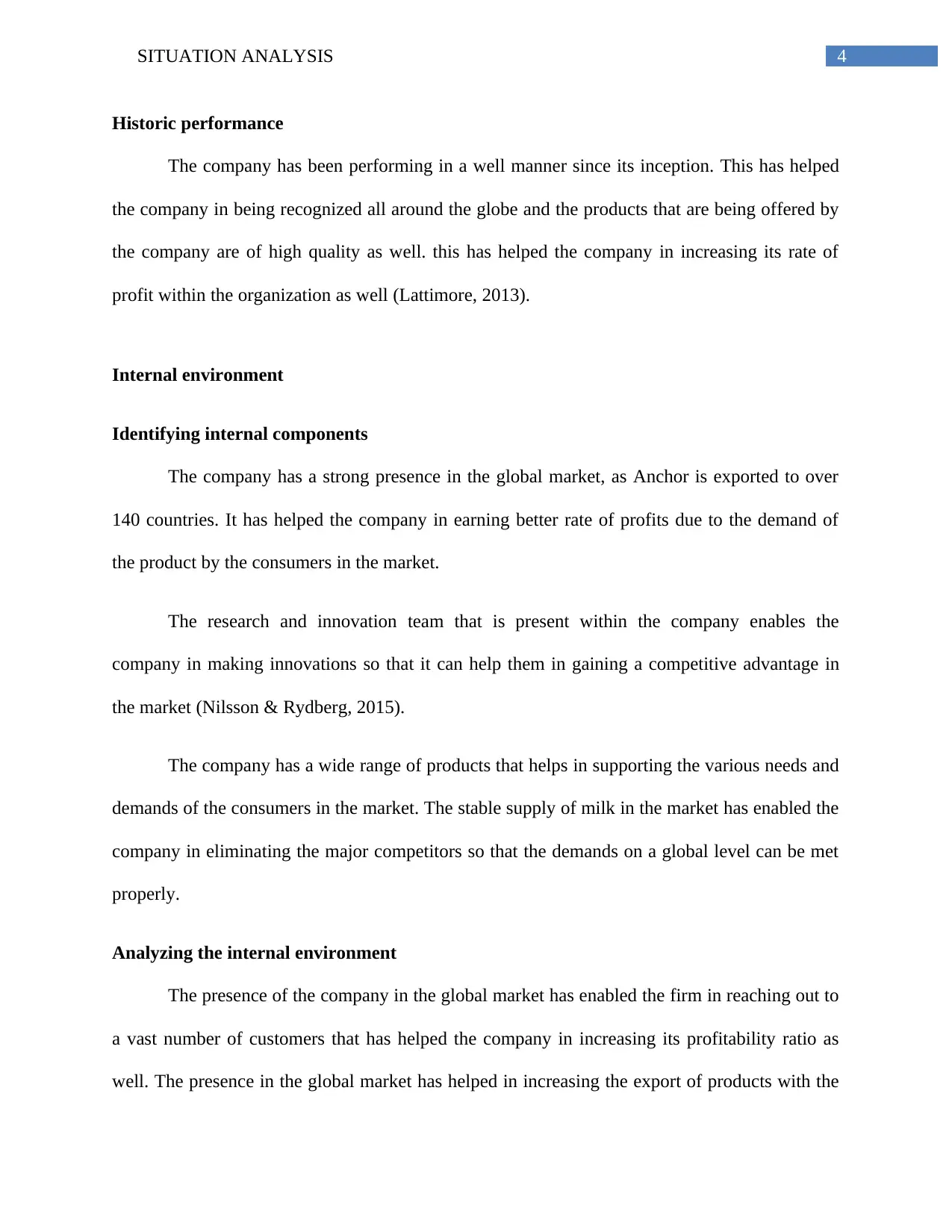
4SITUATION ANALYSIS
Historic performance
The company has been performing in a well manner since its inception. This has helped
the company in being recognized all around the globe and the products that are being offered by
the company are of high quality as well. this has helped the company in increasing its rate of
profit within the organization as well (Lattimore, 2013).
Internal environment
Identifying internal components
The company has a strong presence in the global market, as Anchor is exported to over
140 countries. It has helped the company in earning better rate of profits due to the demand of
the product by the consumers in the market.
The research and innovation team that is present within the company enables the
company in making innovations so that it can help them in gaining a competitive advantage in
the market (Nilsson & Rydberg, 2015).
The company has a wide range of products that helps in supporting the various needs and
demands of the consumers in the market. The stable supply of milk in the market has enabled the
company in eliminating the major competitors so that the demands on a global level can be met
properly.
Analyzing the internal environment
The presence of the company in the global market has enabled the firm in reaching out to
a vast number of customers that has helped the company in increasing its profitability ratio as
well. The presence in the global market has helped in increasing the export of products with the
Historic performance
The company has been performing in a well manner since its inception. This has helped
the company in being recognized all around the globe and the products that are being offered by
the company are of high quality as well. this has helped the company in increasing its rate of
profit within the organization as well (Lattimore, 2013).
Internal environment
Identifying internal components
The company has a strong presence in the global market, as Anchor is exported to over
140 countries. It has helped the company in earning better rate of profits due to the demand of
the product by the consumers in the market.
The research and innovation team that is present within the company enables the
company in making innovations so that it can help them in gaining a competitive advantage in
the market (Nilsson & Rydberg, 2015).
The company has a wide range of products that helps in supporting the various needs and
demands of the consumers in the market. The stable supply of milk in the market has enabled the
company in eliminating the major competitors so that the demands on a global level can be met
properly.
Analyzing the internal environment
The presence of the company in the global market has enabled the firm in reaching out to
a vast number of customers that has helped the company in increasing its profitability ratio as
well. The presence in the global market has helped in increasing the export of products with the
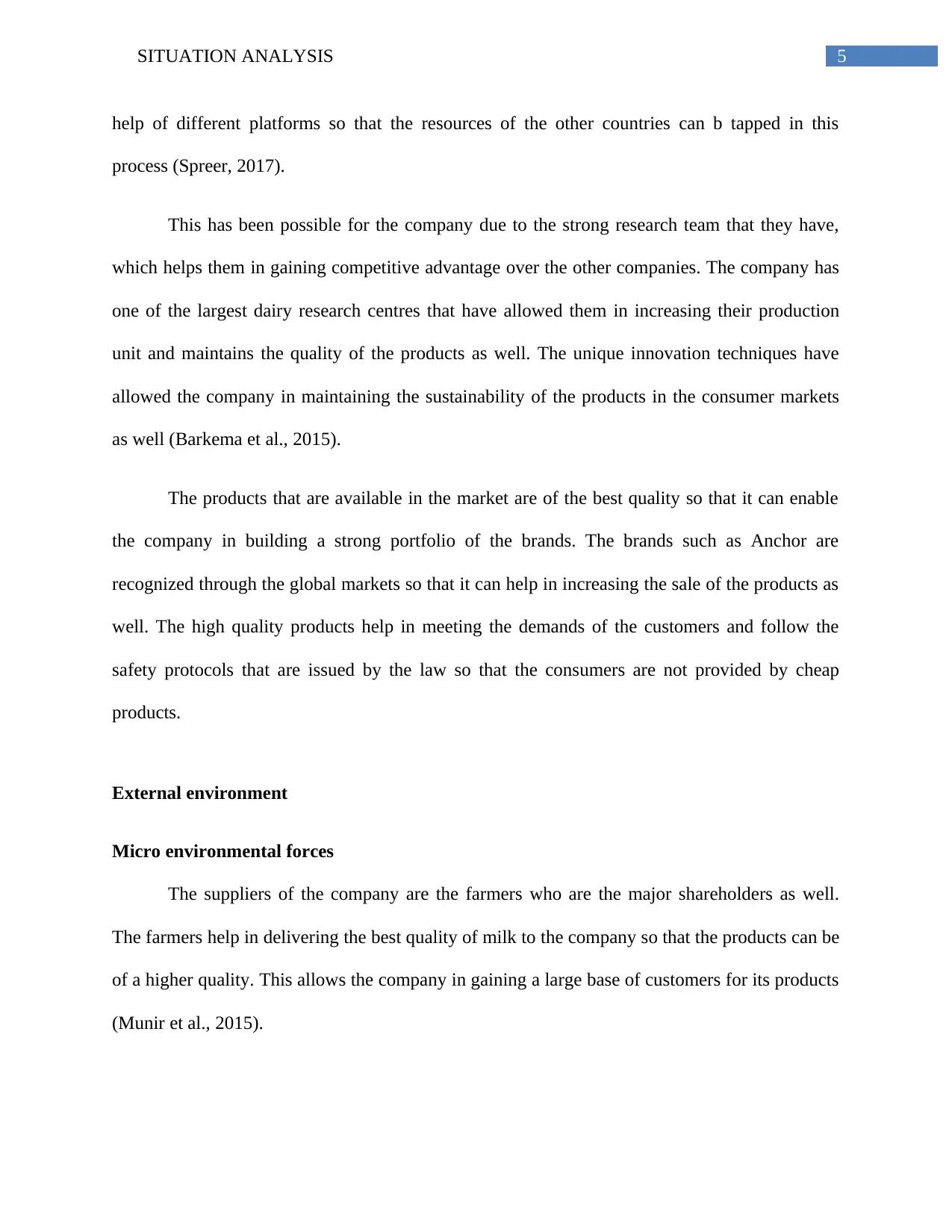
5SITUATION ANALYSIS
help of different platforms so that the resources of the other countries can b tapped in this
process (Spreer, 2017).
This has been possible for the company due to the strong research team that they have,
which helps them in gaining competitive advantage over the other companies. The company has
one of the largest dairy research centres that have allowed them in increasing their production
unit and maintains the quality of the products as well. The unique innovation techniques have
allowed the company in maintaining the sustainability of the products in the consumer markets
as well (Barkema et al., 2015).
The products that are available in the market are of the best quality so that it can enable
the company in building a strong portfolio of the brands. The brands such as Anchor are
recognized through the global markets so that it can help in increasing the sale of the products as
well. The high quality products help in meeting the demands of the customers and follow the
safety protocols that are issued by the law so that the consumers are not provided by cheap
products.
External environment
Micro environmental forces
The suppliers of the company are the farmers who are the major shareholders as well.
The farmers help in delivering the best quality of milk to the company so that the products can be
of a higher quality. This allows the company in gaining a large base of customers for its products
(Munir et al., 2015).
help of different platforms so that the resources of the other countries can b tapped in this
process (Spreer, 2017).
This has been possible for the company due to the strong research team that they have,
which helps them in gaining competitive advantage over the other companies. The company has
one of the largest dairy research centres that have allowed them in increasing their production
unit and maintains the quality of the products as well. The unique innovation techniques have
allowed the company in maintaining the sustainability of the products in the consumer markets
as well (Barkema et al., 2015).
The products that are available in the market are of the best quality so that it can enable
the company in building a strong portfolio of the brands. The brands such as Anchor are
recognized through the global markets so that it can help in increasing the sale of the products as
well. The high quality products help in meeting the demands of the customers and follow the
safety protocols that are issued by the law so that the consumers are not provided by cheap
products.
External environment
Micro environmental forces
The suppliers of the company are the farmers who are the major shareholders as well.
The farmers help in delivering the best quality of milk to the company so that the products can be
of a higher quality. This allows the company in gaining a large base of customers for its products
(Munir et al., 2015).
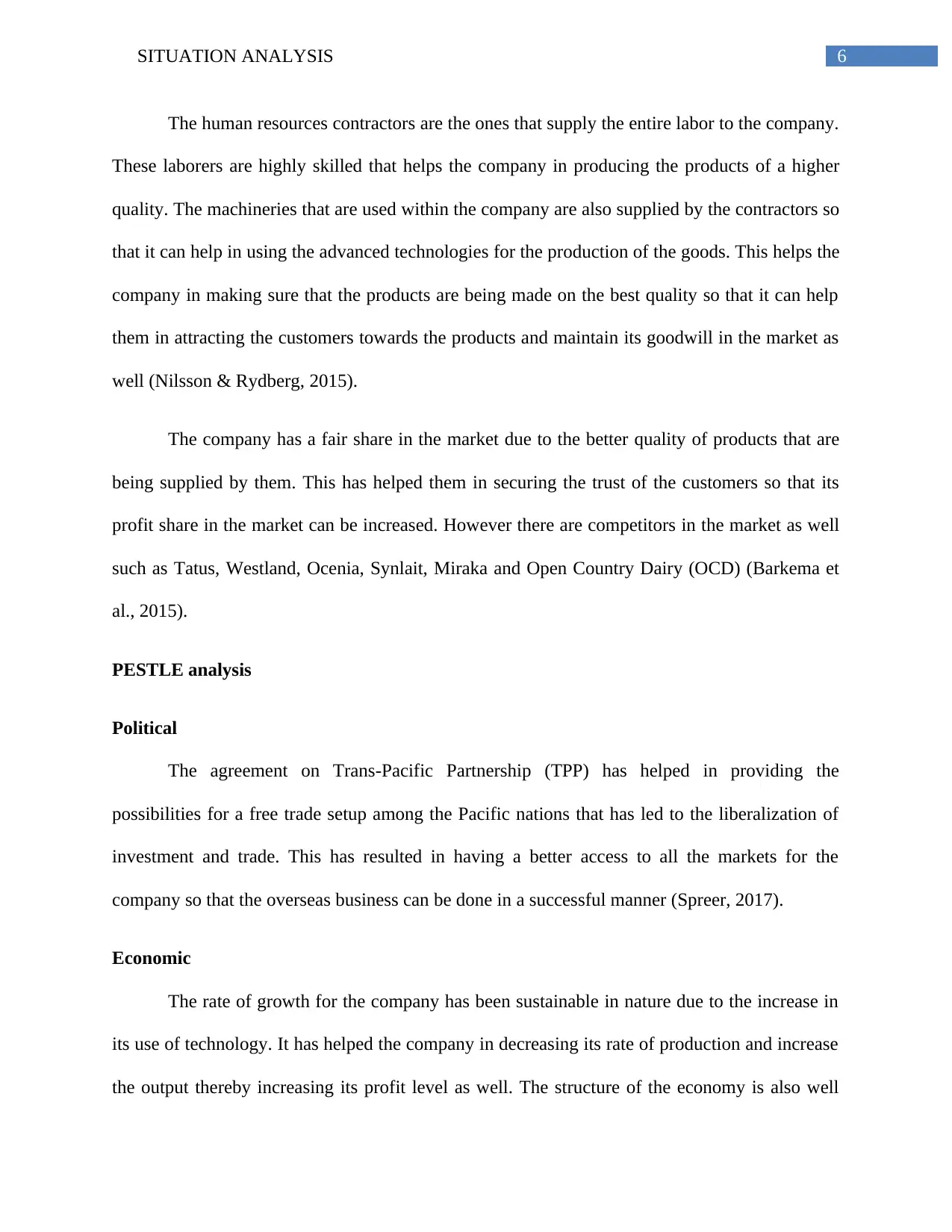
6SITUATION ANALYSIS
The human resources contractors are the ones that supply the entire labor to the company.
These laborers are highly skilled that helps the company in producing the products of a higher
quality. The machineries that are used within the company are also supplied by the contractors so
that it can help in using the advanced technologies for the production of the goods. This helps the
company in making sure that the products are being made on the best quality so that it can help
them in attracting the customers towards the products and maintain its goodwill in the market as
well (Nilsson & Rydberg, 2015).
The company has a fair share in the market due to the better quality of products that are
being supplied by them. This has helped them in securing the trust of the customers so that its
profit share in the market can be increased. However there are competitors in the market as well
such as Tatus, Westland, Ocenia, Synlait, Miraka and Open Country Dairy (OCD) (Barkema et
al., 2015).
PESTLE analysis
Political
The agreement on Trans-Pacific Partnership (TPP) has helped in providing the
possibilities for a free trade setup among the Pacific nations that has led to the liberalization of
investment and trade. This has resulted in having a better access to all the markets for the
company so that the overseas business can be done in a successful manner (Spreer, 2017).
Economic
The rate of growth for the company has been sustainable in nature due to the increase in
its use of technology. It has helped the company in decreasing its rate of production and increase
the output thereby increasing its profit level as well. The structure of the economy is also well
The human resources contractors are the ones that supply the entire labor to the company.
These laborers are highly skilled that helps the company in producing the products of a higher
quality. The machineries that are used within the company are also supplied by the contractors so
that it can help in using the advanced technologies for the production of the goods. This helps the
company in making sure that the products are being made on the best quality so that it can help
them in attracting the customers towards the products and maintain its goodwill in the market as
well (Nilsson & Rydberg, 2015).
The company has a fair share in the market due to the better quality of products that are
being supplied by them. This has helped them in securing the trust of the customers so that its
profit share in the market can be increased. However there are competitors in the market as well
such as Tatus, Westland, Ocenia, Synlait, Miraka and Open Country Dairy (OCD) (Barkema et
al., 2015).
PESTLE analysis
Political
The agreement on Trans-Pacific Partnership (TPP) has helped in providing the
possibilities for a free trade setup among the Pacific nations that has led to the liberalization of
investment and trade. This has resulted in having a better access to all the markets for the
company so that the overseas business can be done in a successful manner (Spreer, 2017).
Economic
The rate of growth for the company has been sustainable in nature due to the increase in
its use of technology. It has helped the company in decreasing its rate of production and increase
the output thereby increasing its profit level as well. The structure of the economy is also well
Paraphrase This Document
Need a fresh take? Get an instant paraphrase of this document with our AI Paraphraser
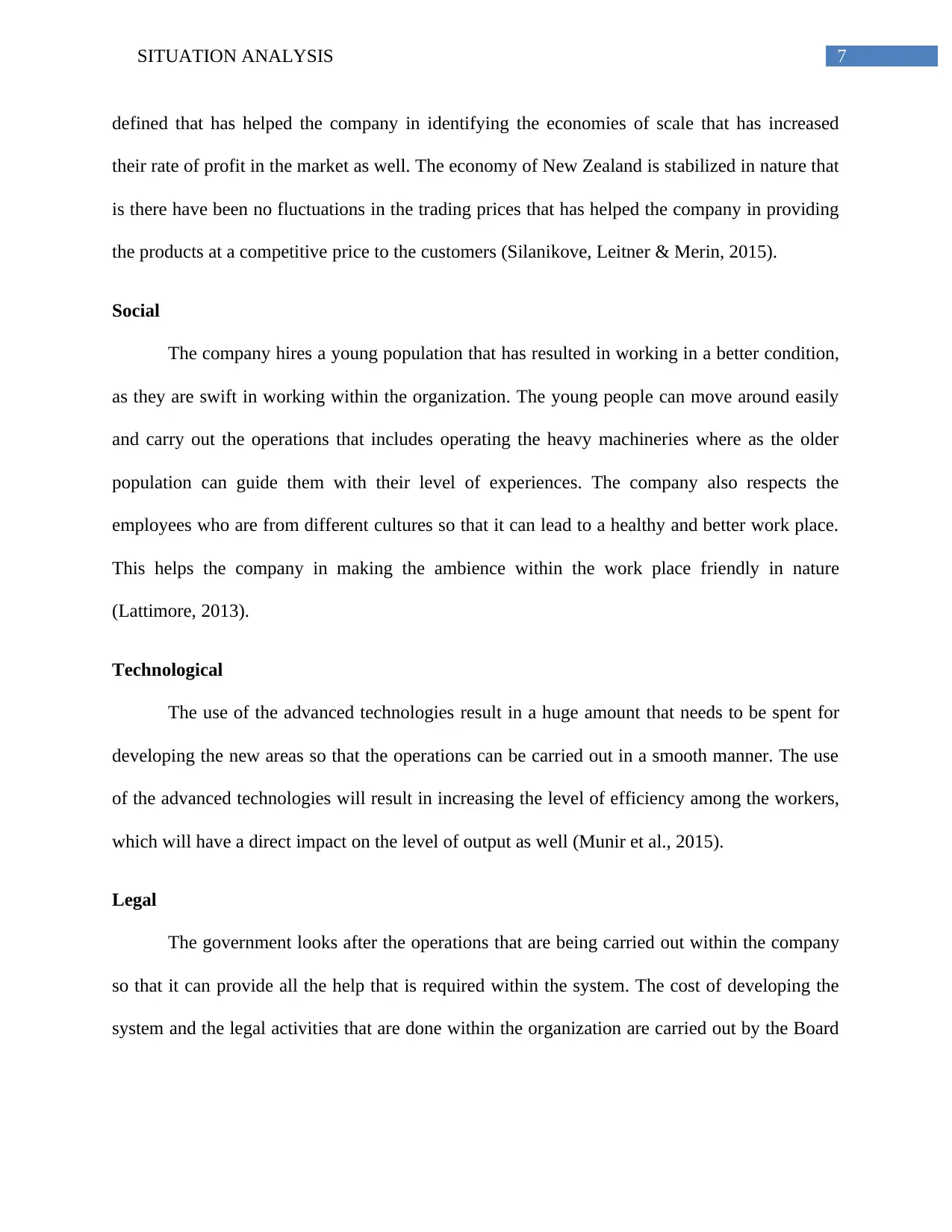
7SITUATION ANALYSIS
defined that has helped the company in identifying the economies of scale that has increased
their rate of profit in the market as well. The economy of New Zealand is stabilized in nature that
is there have been no fluctuations in the trading prices that has helped the company in providing
the products at a competitive price to the customers (Silanikove, Leitner & Merin, 2015).
Social
The company hires a young population that has resulted in working in a better condition,
as they are swift in working within the organization. The young people can move around easily
and carry out the operations that includes operating the heavy machineries where as the older
population can guide them with their level of experiences. The company also respects the
employees who are from different cultures so that it can lead to a healthy and better work place.
This helps the company in making the ambience within the work place friendly in nature
(Lattimore, 2013).
Technological
The use of the advanced technologies result in a huge amount that needs to be spent for
developing the new areas so that the operations can be carried out in a smooth manner. The use
of the advanced technologies will result in increasing the level of efficiency among the workers,
which will have a direct impact on the level of output as well (Munir et al., 2015).
Legal
The government looks after the operations that are being carried out within the company
so that it can provide all the help that is required within the system. The cost of developing the
system and the legal activities that are done within the organization are carried out by the Board
defined that has helped the company in identifying the economies of scale that has increased
their rate of profit in the market as well. The economy of New Zealand is stabilized in nature that
is there have been no fluctuations in the trading prices that has helped the company in providing
the products at a competitive price to the customers (Silanikove, Leitner & Merin, 2015).
Social
The company hires a young population that has resulted in working in a better condition,
as they are swift in working within the organization. The young people can move around easily
and carry out the operations that includes operating the heavy machineries where as the older
population can guide them with their level of experiences. The company also respects the
employees who are from different cultures so that it can lead to a healthy and better work place.
This helps the company in making the ambience within the work place friendly in nature
(Lattimore, 2013).
Technological
The use of the advanced technologies result in a huge amount that needs to be spent for
developing the new areas so that the operations can be carried out in a smooth manner. The use
of the advanced technologies will result in increasing the level of efficiency among the workers,
which will have a direct impact on the level of output as well (Munir et al., 2015).
Legal
The government looks after the operations that are being carried out within the company
so that it can provide all the help that is required within the system. The cost of developing the
system and the legal activities that are done within the organization are carried out by the Board
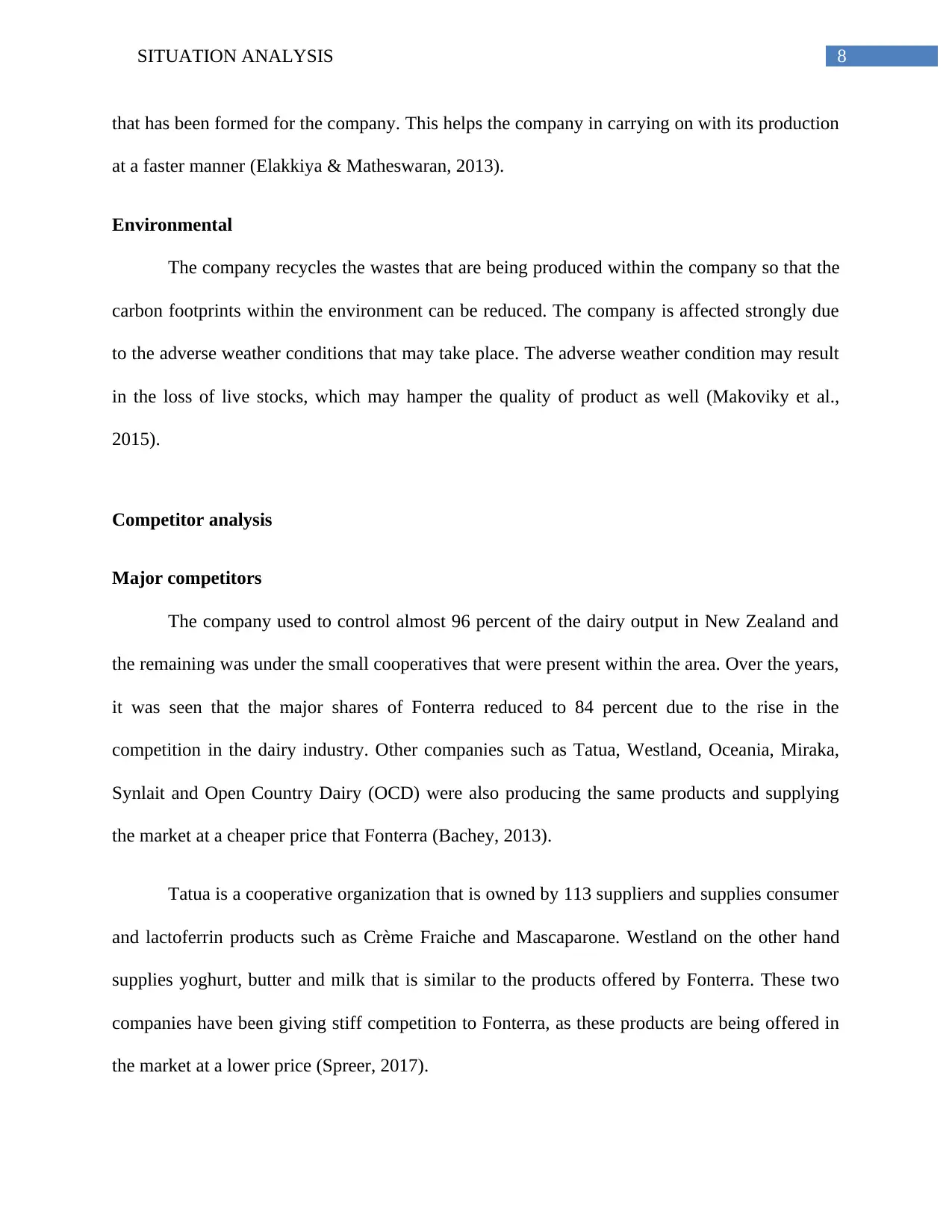
8SITUATION ANALYSIS
that has been formed for the company. This helps the company in carrying on with its production
at a faster manner (Elakkiya & Matheswaran, 2013).
Environmental
The company recycles the wastes that are being produced within the company so that the
carbon footprints within the environment can be reduced. The company is affected strongly due
to the adverse weather conditions that may take place. The adverse weather condition may result
in the loss of live stocks, which may hamper the quality of product as well (Makoviky et al.,
2015).
Competitor analysis
Major competitors
The company used to control almost 96 percent of the dairy output in New Zealand and
the remaining was under the small cooperatives that were present within the area. Over the years,
it was seen that the major shares of Fonterra reduced to 84 percent due to the rise in the
competition in the dairy industry. Other companies such as Tatua, Westland, Oceania, Miraka,
Synlait and Open Country Dairy (OCD) were also producing the same products and supplying
the market at a cheaper price that Fonterra (Bachey, 2013).
Tatua is a cooperative organization that is owned by 113 suppliers and supplies consumer
and lactoferrin products such as Crème Fraiche and Mascaparone. Westland on the other hand
supplies yoghurt, butter and milk that is similar to the products offered by Fonterra. These two
companies have been giving stiff competition to Fonterra, as these products are being offered in
the market at a lower price (Spreer, 2017).
that has been formed for the company. This helps the company in carrying on with its production
at a faster manner (Elakkiya & Matheswaran, 2013).
Environmental
The company recycles the wastes that are being produced within the company so that the
carbon footprints within the environment can be reduced. The company is affected strongly due
to the adverse weather conditions that may take place. The adverse weather condition may result
in the loss of live stocks, which may hamper the quality of product as well (Makoviky et al.,
2015).
Competitor analysis
Major competitors
The company used to control almost 96 percent of the dairy output in New Zealand and
the remaining was under the small cooperatives that were present within the area. Over the years,
it was seen that the major shares of Fonterra reduced to 84 percent due to the rise in the
competition in the dairy industry. Other companies such as Tatua, Westland, Oceania, Miraka,
Synlait and Open Country Dairy (OCD) were also producing the same products and supplying
the market at a cheaper price that Fonterra (Bachey, 2013).
Tatua is a cooperative organization that is owned by 113 suppliers and supplies consumer
and lactoferrin products such as Crème Fraiche and Mascaparone. Westland on the other hand
supplies yoghurt, butter and milk that is similar to the products offered by Fonterra. These two
companies have been giving stiff competition to Fonterra, as these products are being offered in
the market at a lower price (Spreer, 2017).
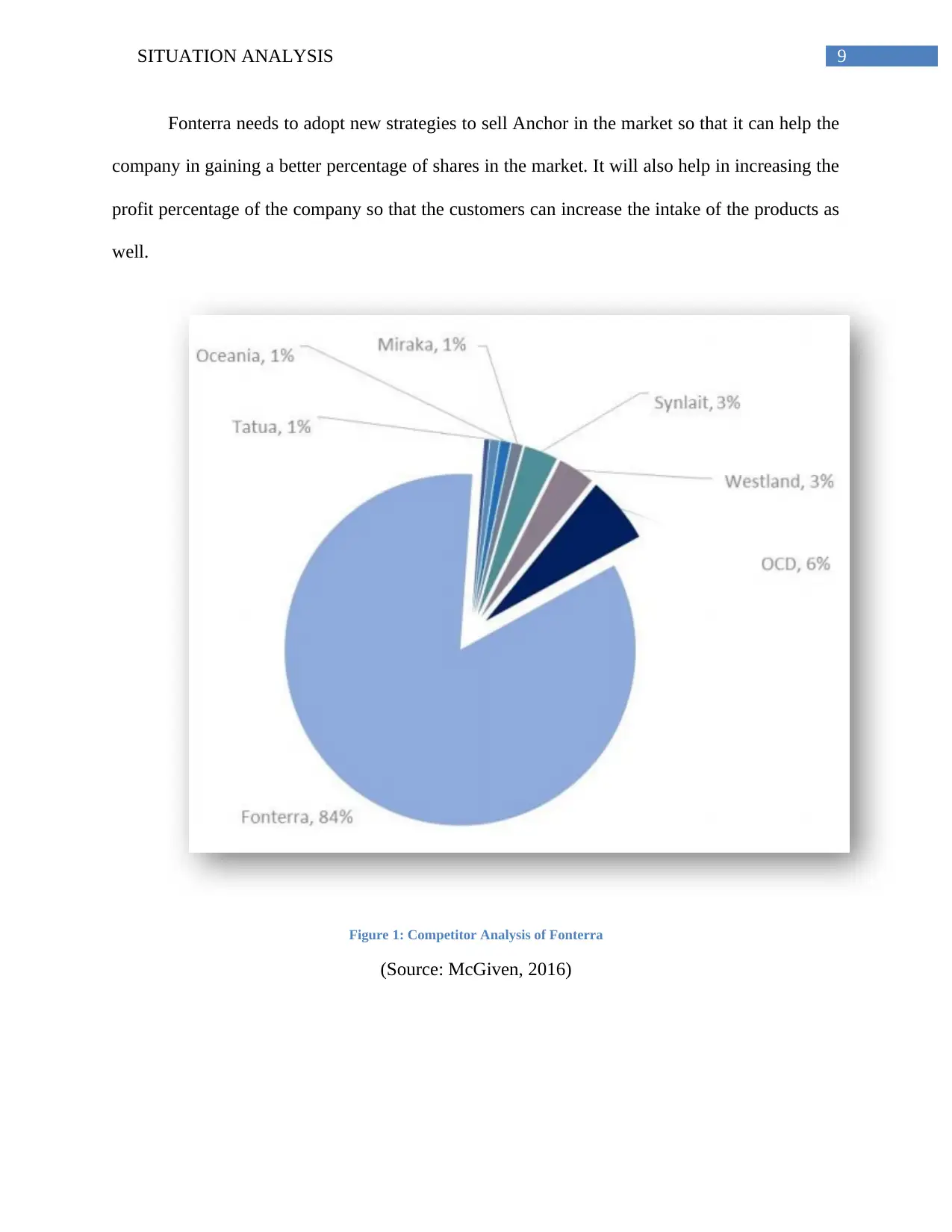
9SITUATION ANALYSIS
Fonterra needs to adopt new strategies to sell Anchor in the market so that it can help the
company in gaining a better percentage of shares in the market. It will also help in increasing the
profit percentage of the company so that the customers can increase the intake of the products as
well.
Figure 1: Competitor Analysis of Fonterra
(Source: McGiven, 2016)
Fonterra needs to adopt new strategies to sell Anchor in the market so that it can help the
company in gaining a better percentage of shares in the market. It will also help in increasing the
profit percentage of the company so that the customers can increase the intake of the products as
well.
Figure 1: Competitor Analysis of Fonterra
(Source: McGiven, 2016)
Secure Best Marks with AI Grader
Need help grading? Try our AI Grader for instant feedback on your assignments.
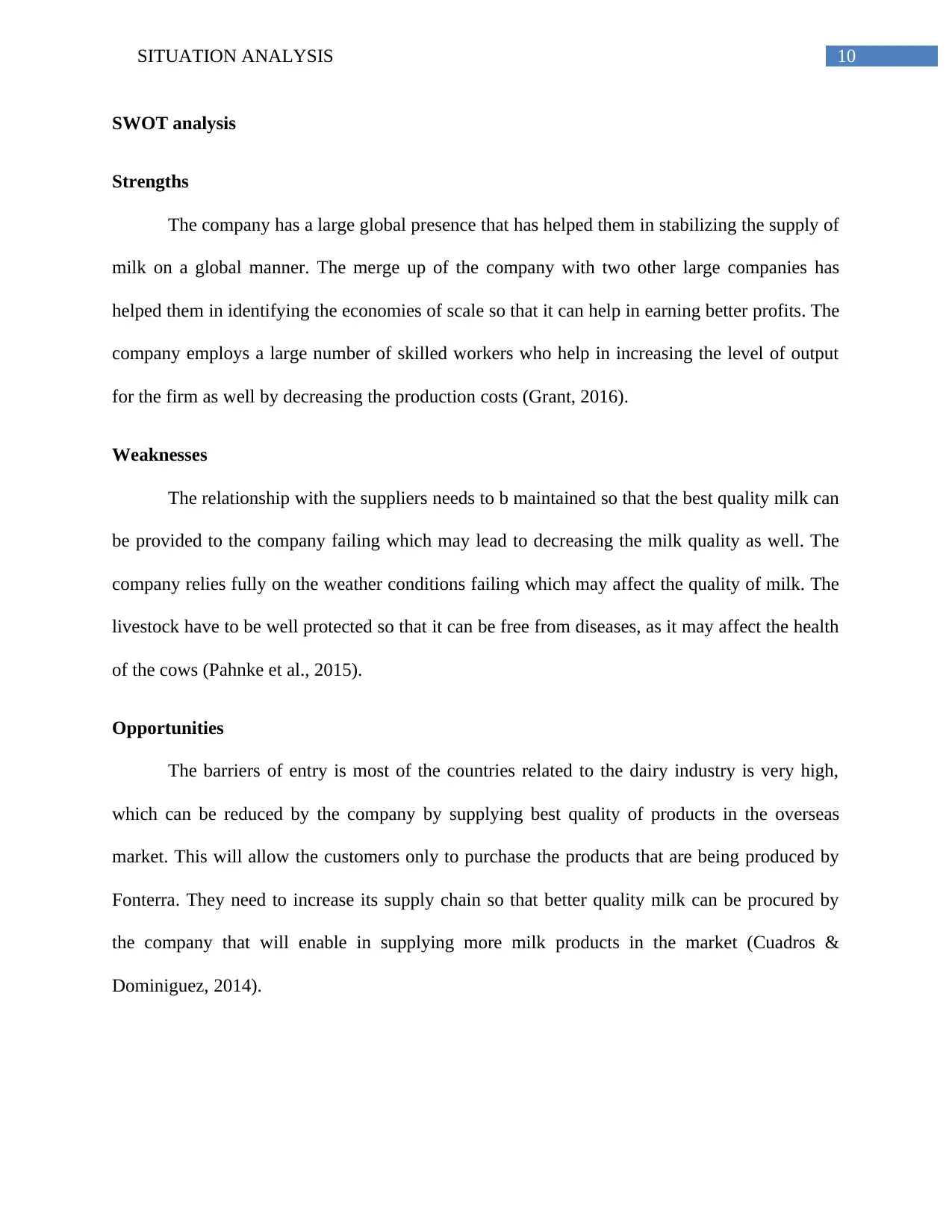
10SITUATION ANALYSIS
SWOT analysis
Strengths
The company has a large global presence that has helped them in stabilizing the supply of
milk on a global manner. The merge up of the company with two other large companies has
helped them in identifying the economies of scale so that it can help in earning better profits. The
company employs a large number of skilled workers who help in increasing the level of output
for the firm as well by decreasing the production costs (Grant, 2016).
Weaknesses
The relationship with the suppliers needs to b maintained so that the best quality milk can
be provided to the company failing which may lead to decreasing the milk quality as well. The
company relies fully on the weather conditions failing which may affect the quality of milk. The
livestock have to be well protected so that it can be free from diseases, as it may affect the health
of the cows (Pahnke et al., 2015).
Opportunities
The barriers of entry is most of the countries related to the dairy industry is very high,
which can be reduced by the company by supplying best quality of products in the overseas
market. This will allow the customers only to purchase the products that are being produced by
Fonterra. They need to increase its supply chain so that better quality milk can be procured by
the company that will enable in supplying more milk products in the market (Cuadros &
Dominiguez, 2014).
SWOT analysis
Strengths
The company has a large global presence that has helped them in stabilizing the supply of
milk on a global manner. The merge up of the company with two other large companies has
helped them in identifying the economies of scale so that it can help in earning better profits. The
company employs a large number of skilled workers who help in increasing the level of output
for the firm as well by decreasing the production costs (Grant, 2016).
Weaknesses
The relationship with the suppliers needs to b maintained so that the best quality milk can
be provided to the company failing which may lead to decreasing the milk quality as well. The
company relies fully on the weather conditions failing which may affect the quality of milk. The
livestock have to be well protected so that it can be free from diseases, as it may affect the health
of the cows (Pahnke et al., 2015).
Opportunities
The barriers of entry is most of the countries related to the dairy industry is very high,
which can be reduced by the company by supplying best quality of products in the overseas
market. This will allow the customers only to purchase the products that are being produced by
Fonterra. They need to increase its supply chain so that better quality milk can be procured by
the company that will enable in supplying more milk products in the market (Cuadros &
Dominiguez, 2014).
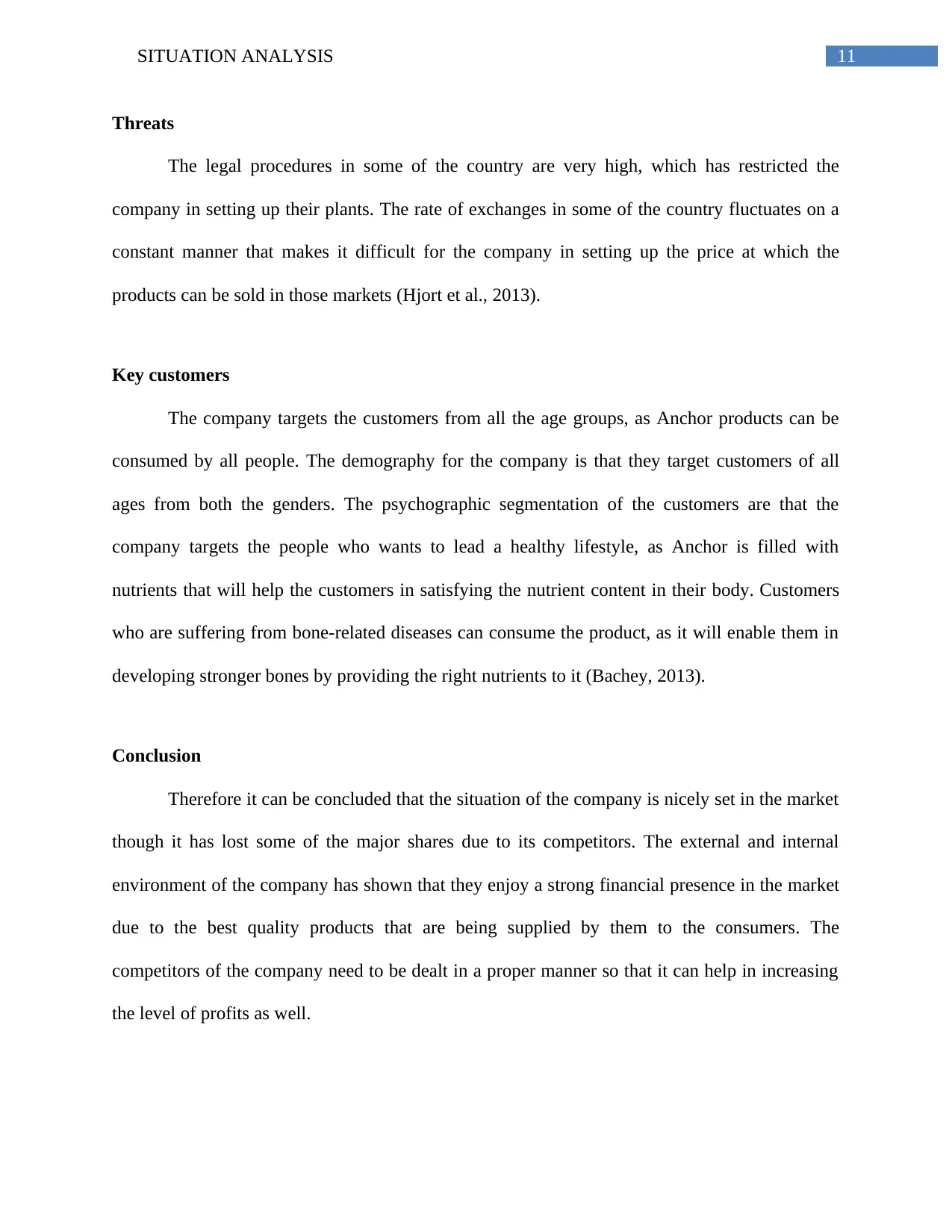
11SITUATION ANALYSIS
Threats
The legal procedures in some of the country are very high, which has restricted the
company in setting up their plants. The rate of exchanges in some of the country fluctuates on a
constant manner that makes it difficult for the company in setting up the price at which the
products can be sold in those markets (Hjort et al., 2013).
Key customers
The company targets the customers from all the age groups, as Anchor products can be
consumed by all people. The demography for the company is that they target customers of all
ages from both the genders. The psychographic segmentation of the customers are that the
company targets the people who wants to lead a healthy lifestyle, as Anchor is filled with
nutrients that will help the customers in satisfying the nutrient content in their body. Customers
who are suffering from bone-related diseases can consume the product, as it will enable them in
developing stronger bones by providing the right nutrients to it (Bachey, 2013).
Conclusion
Therefore it can be concluded that the situation of the company is nicely set in the market
though it has lost some of the major shares due to its competitors. The external and internal
environment of the company has shown that they enjoy a strong financial presence in the market
due to the best quality products that are being supplied by them to the consumers. The
competitors of the company need to be dealt in a proper manner so that it can help in increasing
the level of profits as well.
Threats
The legal procedures in some of the country are very high, which has restricted the
company in setting up their plants. The rate of exchanges in some of the country fluctuates on a
constant manner that makes it difficult for the company in setting up the price at which the
products can be sold in those markets (Hjort et al., 2013).
Key customers
The company targets the customers from all the age groups, as Anchor products can be
consumed by all people. The demography for the company is that they target customers of all
ages from both the genders. The psychographic segmentation of the customers are that the
company targets the people who wants to lead a healthy lifestyle, as Anchor is filled with
nutrients that will help the customers in satisfying the nutrient content in their body. Customers
who are suffering from bone-related diseases can consume the product, as it will enable them in
developing stronger bones by providing the right nutrients to it (Bachey, 2013).
Conclusion
Therefore it can be concluded that the situation of the company is nicely set in the market
though it has lost some of the major shares due to its competitors. The external and internal
environment of the company has shown that they enjoy a strong financial presence in the market
due to the best quality products that are being supplied by them to the consumers. The
competitors of the company need to be dealt in a proper manner so that it can help in increasing
the level of profits as well.
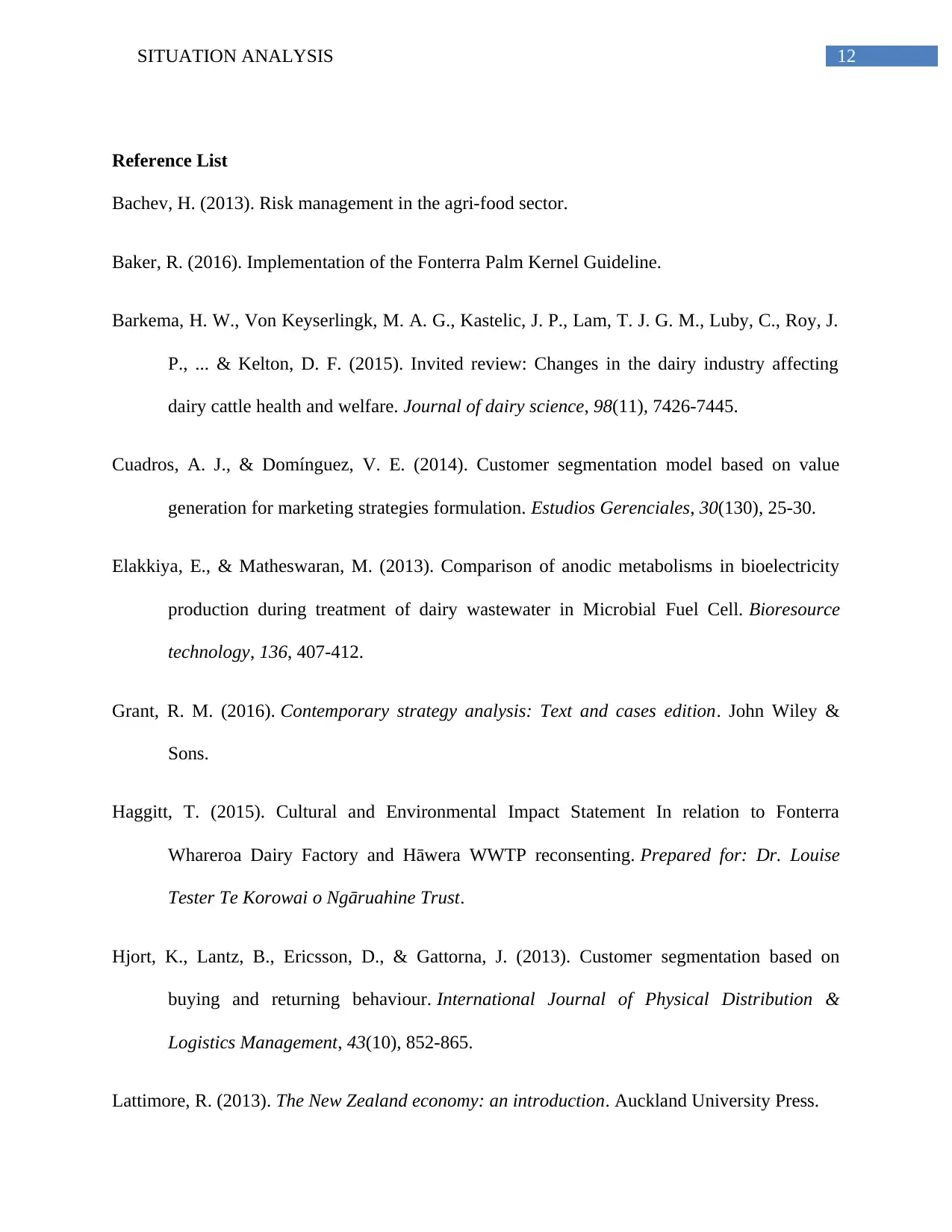
12SITUATION ANALYSIS
Reference List
Bachev, H. (2013). Risk management in the agri-food sector.
Baker, R. (2016). Implementation of the Fonterra Palm Kernel Guideline.
Barkema, H. W., Von Keyserlingk, M. A. G., Kastelic, J. P., Lam, T. J. G. M., Luby, C., Roy, J.
P., ... & Kelton, D. F. (2015). Invited review: Changes in the dairy industry affecting
dairy cattle health and welfare. Journal of dairy science, 98(11), 7426-7445.
Cuadros, A. J., & Domínguez, V. E. (2014). Customer segmentation model based on value
generation for marketing strategies formulation. Estudios Gerenciales, 30(130), 25-30.
Elakkiya, E., & Matheswaran, M. (2013). Comparison of anodic metabolisms in bioelectricity
production during treatment of dairy wastewater in Microbial Fuel Cell. Bioresource
technology, 136, 407-412.
Grant, R. M. (2016). Contemporary strategy analysis: Text and cases edition. John Wiley &
Sons.
Haggitt, T. (2015). Cultural and Environmental Impact Statement In relation to Fonterra
Whareroa Dairy Factory and Hāwera WWTP reconsenting. Prepared for: Dr. Louise
Tester Te Korowai o Ngāruahine Trust.
Hjort, K., Lantz, B., Ericsson, D., & Gattorna, J. (2013). Customer segmentation based on
buying and returning behaviour. International Journal of Physical Distribution &
Logistics Management, 43(10), 852-865.
Lattimore, R. (2013). The New Zealand economy: an introduction. Auckland University Press.
Reference List
Bachev, H. (2013). Risk management in the agri-food sector.
Baker, R. (2016). Implementation of the Fonterra Palm Kernel Guideline.
Barkema, H. W., Von Keyserlingk, M. A. G., Kastelic, J. P., Lam, T. J. G. M., Luby, C., Roy, J.
P., ... & Kelton, D. F. (2015). Invited review: Changes in the dairy industry affecting
dairy cattle health and welfare. Journal of dairy science, 98(11), 7426-7445.
Cuadros, A. J., & Domínguez, V. E. (2014). Customer segmentation model based on value
generation for marketing strategies formulation. Estudios Gerenciales, 30(130), 25-30.
Elakkiya, E., & Matheswaran, M. (2013). Comparison of anodic metabolisms in bioelectricity
production during treatment of dairy wastewater in Microbial Fuel Cell. Bioresource
technology, 136, 407-412.
Grant, R. M. (2016). Contemporary strategy analysis: Text and cases edition. John Wiley &
Sons.
Haggitt, T. (2015). Cultural and Environmental Impact Statement In relation to Fonterra
Whareroa Dairy Factory and Hāwera WWTP reconsenting. Prepared for: Dr. Louise
Tester Te Korowai o Ngāruahine Trust.
Hjort, K., Lantz, B., Ericsson, D., & Gattorna, J. (2013). Customer segmentation based on
buying and returning behaviour. International Journal of Physical Distribution &
Logistics Management, 43(10), 852-865.
Lattimore, R. (2013). The New Zealand economy: an introduction. Auckland University Press.
Paraphrase This Document
Need a fresh take? Get an instant paraphrase of this document with our AI Paraphraser
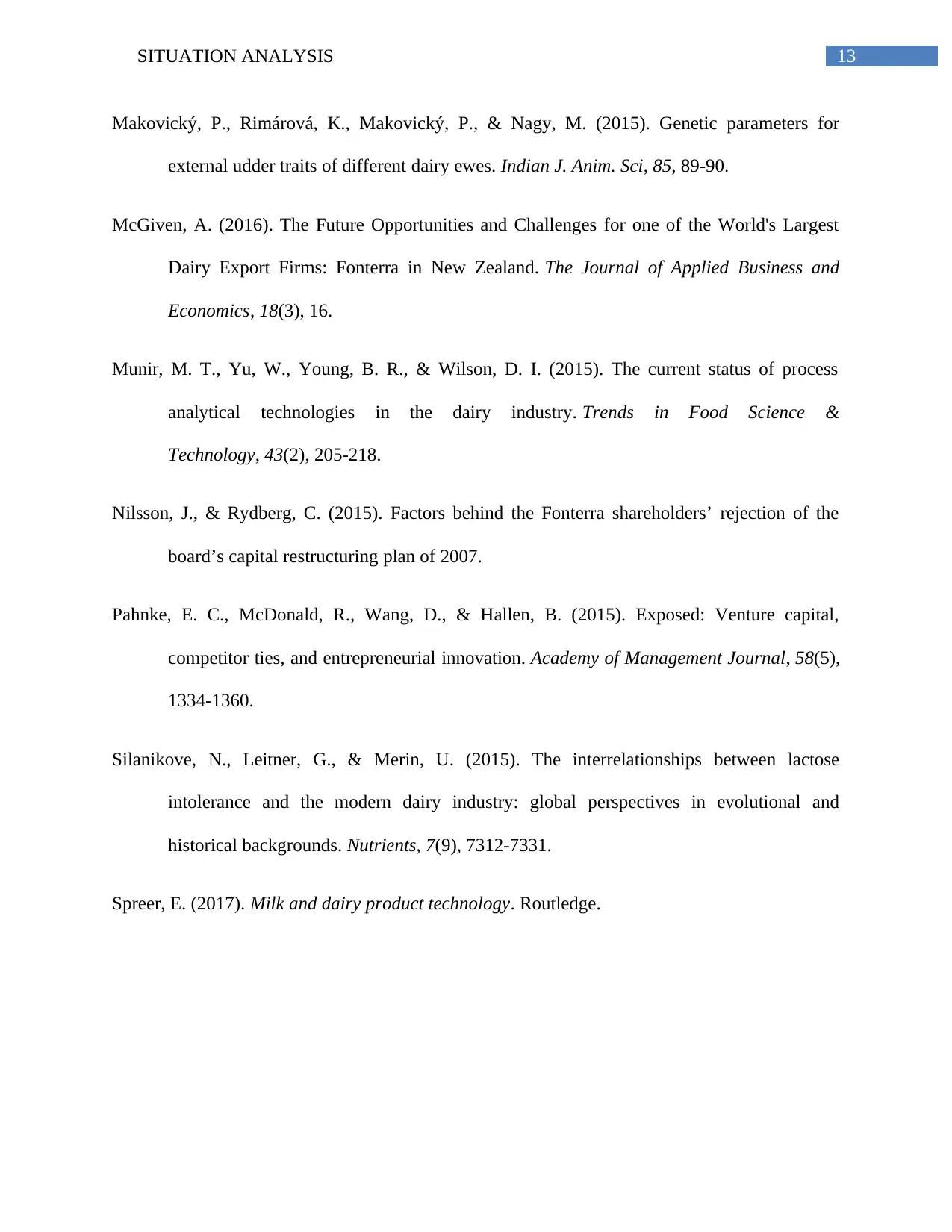
13SITUATION ANALYSIS
Makovický, P., Rimárová, K., Makovický, P., & Nagy, M. (2015). Genetic parameters for
external udder traits of different dairy ewes. Indian J. Anim. Sci, 85, 89-90.
McGiven, A. (2016). The Future Opportunities and Challenges for one of the World's Largest
Dairy Export Firms: Fonterra in New Zealand. The Journal of Applied Business and
Economics, 18(3), 16.
Munir, M. T., Yu, W., Young, B. R., & Wilson, D. I. (2015). The current status of process
analytical technologies in the dairy industry. Trends in Food Science &
Technology, 43(2), 205-218.
Nilsson, J., & Rydberg, C. (2015). Factors behind the Fonterra shareholders’ rejection of the
board’s capital restructuring plan of 2007.
Pahnke, E. C., McDonald, R., Wang, D., & Hallen, B. (2015). Exposed: Venture capital,
competitor ties, and entrepreneurial innovation. Academy of Management Journal, 58(5),
1334-1360.
Silanikove, N., Leitner, G., & Merin, U. (2015). The interrelationships between lactose
intolerance and the modern dairy industry: global perspectives in evolutional and
historical backgrounds. Nutrients, 7(9), 7312-7331.
Spreer, E. (2017). Milk and dairy product technology. Routledge.
Makovický, P., Rimárová, K., Makovický, P., & Nagy, M. (2015). Genetic parameters for
external udder traits of different dairy ewes. Indian J. Anim. Sci, 85, 89-90.
McGiven, A. (2016). The Future Opportunities and Challenges for one of the World's Largest
Dairy Export Firms: Fonterra in New Zealand. The Journal of Applied Business and
Economics, 18(3), 16.
Munir, M. T., Yu, W., Young, B. R., & Wilson, D. I. (2015). The current status of process
analytical technologies in the dairy industry. Trends in Food Science &
Technology, 43(2), 205-218.
Nilsson, J., & Rydberg, C. (2015). Factors behind the Fonterra shareholders’ rejection of the
board’s capital restructuring plan of 2007.
Pahnke, E. C., McDonald, R., Wang, D., & Hallen, B. (2015). Exposed: Venture capital,
competitor ties, and entrepreneurial innovation. Academy of Management Journal, 58(5),
1334-1360.
Silanikove, N., Leitner, G., & Merin, U. (2015). The interrelationships between lactose
intolerance and the modern dairy industry: global perspectives in evolutional and
historical backgrounds. Nutrients, 7(9), 7312-7331.
Spreer, E. (2017). Milk and dairy product technology. Routledge.
1 out of 14
Related Documents
Your All-in-One AI-Powered Toolkit for Academic Success.
+13062052269
info@desklib.com
Available 24*7 on WhatsApp / Email
![[object Object]](/_next/static/media/star-bottom.7253800d.svg)
Unlock your academic potential
© 2024 | Zucol Services PVT LTD | All rights reserved.





